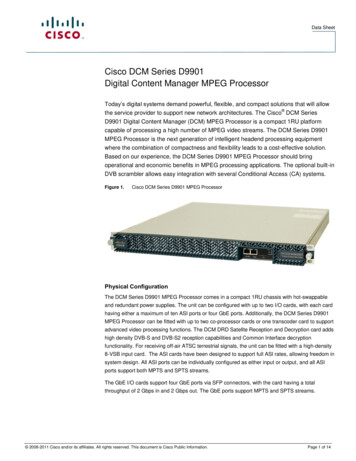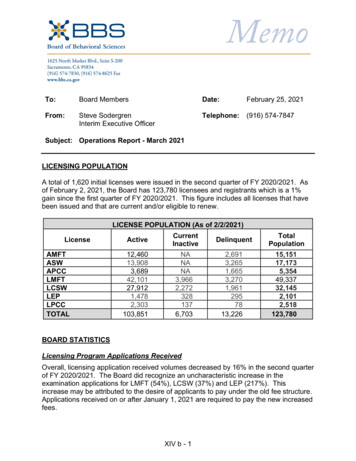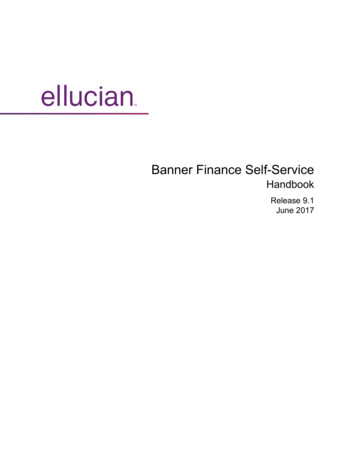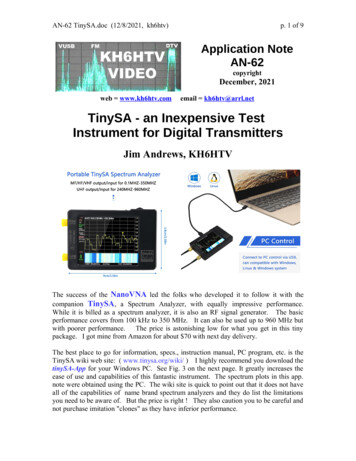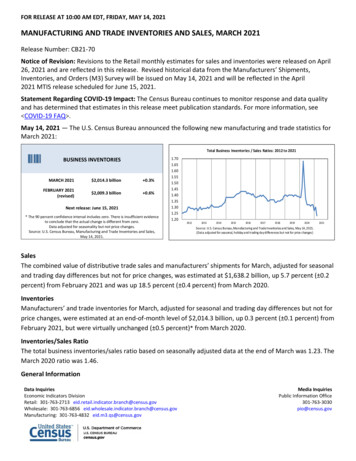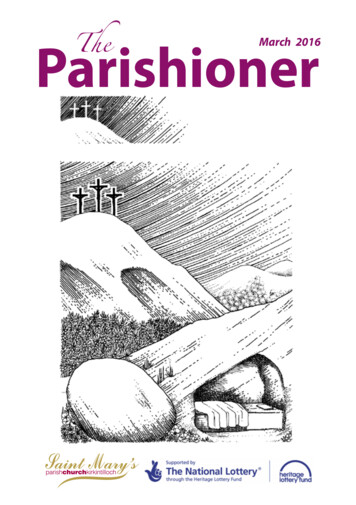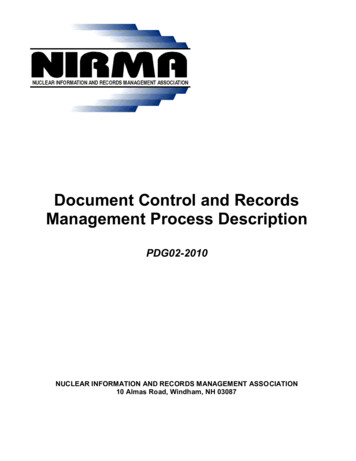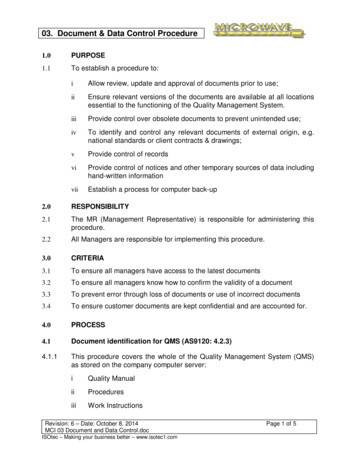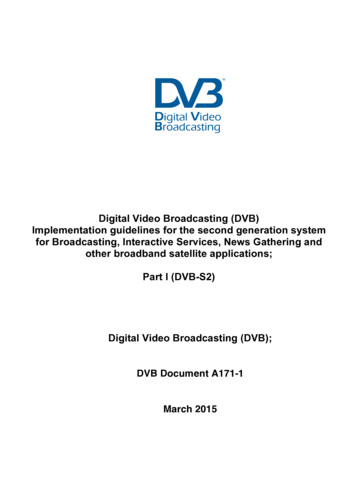
Transcription
!!!!!!!!!!!!!!Digital Video Broadcasting (DVB)Implementation guidelines for the second generation systemfor Broadcasting, Interactive Services, News Gathering andother broadband satellite applications;Part I (DVB-S2)!Digital Video Broadcasting (DVB);DVB Document A171-1March 2015
3ContentsIntellectual Property Rights . 5Foreword. 51Scope . 62References . 63Symbols and abbreviations. .2.7Symbols . 8Abbreviations . 9General description of the technical characteristics of the DVB-S2 system . 11Commercial requirements . 12Commercial Requirements for Broadcast Services . 12Commercial Requirements for Non-Broadcast Services . 13Common Commercial Requirements . 14Application scenarios . 14System architecture . 15The system block diagram. 18Reference performance . 19Adaptive Coding and Modulation . 30ACM: the principles . 30Functional description of the DVB-S2 subsystem for ACM . 34DVB-S2 performance in ACM mode . 39System configurations. 40Broadcast applications. 40SDTV broadcasting. 41SDTV and HDTV broadcasting with differentiated channel protection . 41Interactive applications . 42IP Unicast Services . 42Single Generic Stream and ACM command . 43Multiple (Generic or Transport) Streams . 45Encapsulation efficiency of ACM modes . 46Scheduling issues . 49Independent frames structure for Packetized streams with VCM/ACM . 51Independent framing issues (applicable to MPEG-TS) . 51Example slicing process . 52Specific cases . 52Contribution services, data content distribution/trunking and other professional applications. 53Distribution of multiple MPEG multiplexes to Digital Terrestrial TV Transmitters . 53DSNG and other professional applications . 53DSNG bit rates and symbol rates . 54Phase noise recommendation . 54Receiver filter mask . 54DSNG carrier spacing . 54Link budget examples for DSNG . 56DSNG transmitting station identification . 62DSNG Services using ACM . 628Transmission on wideband satellite transponders using time-slicing . 64A.1Structure of Parity Check Matrices of Standardized LDPC Codes . 67A.2Description of Standardized LDPC Codes . 68A.3Performance Results. 69B.1Structured PLS code for Frame Synchronization . 72B.2Pilot Structure. 74DVB BlueBook A171-1
4C.1C.2C.3C.3.1C.3.2C.4Modulator with Pre-Distortion . 76Clock Recovery . 77Physical Layer Frame Synchronization . 78An algorithm for Frame Synchronization. 78An Alternative Frame Synchronization Algorithm . 79Carrier Frequency Recovery . 82C.1Automatic Gain Control . 84C.2Carrier Phase Recovery . 84C.6.1C.6.2Pilot-Aided Linear Interpolation . 84Fine Phase Recovery for High Order Modulations . 86C.3Performance Results . 86D.1System Sizing Issues . 89D.2Methodology Description . 89D.3Study Case Results . 90E.1Channel estimator. 97E.2Physical Layer Selector . 99E.2.1E.2.2Shifted Threshold . 100Hysteresis . 101E.3Performance results . 101F.1Type 1 receiver . 108F.2Type 2 receiver . 108G.1G.2G.2.1G.2.2G.2.3G.3G.3.1PL-Header for time slicing . 110Simple time slice setups . 110Time Slice Sequence . 110Simple Scheduling Assumptions: . 111Examples of TimeSliceCylces. 111Calculation of symbol rate of a simple time slice setups . 111Examples of calculation of symbol rate (simple time-slicing setups) . 112History . 115DVB BlueBook A171-1
5Intellectual Property RightsIPRs essential or potentially essential to the present document may have been declared to ETSI. The informationpertaining to these essential IPRs, if any, is publicly available for ETSI members and non-members, and can be foundin ETSI SR 000 314: "Intellectual Property Rights (IPRs); Essential, or potentially Essential, IPRs notified to ETSI inrespect of ETSI standards", which is available from the ETSI Secretariat. Latest updates are available on the ETSI Webserver (http://webapp.etsi.org/IPR/home.asp).Pursuant to the ETSI IPR Policy, no investigation, including IPR searches, has been carried out by ETSI. No guaranteecan be given as to the existence of other IPRs not referenced in ETSI SR 000 314 (or the updates on the ETSI Webserver) which are, or may be, or may become, essential to the present document.ForewordThis Technical Report (TR) has been produced by Joint Technical Committee (JTC) Broadcast of the EuropeanBroadcasting Union (EBU), Comité Européen de Normalisation ELECtrotechnique (CENELEC) and the EuropeanTelecommunications Standards Institute (ETSI).The work of the JTC was based on the studies carried out by the European DVB Project under the auspices of the AdHoc Group on DVB-S2 of the DVB Technical Module. This joint group of industry, operators and broadcastersprovided the necessary information on all relevant technical matters (see clause 2).NOTE:The EBU/ETSI JTC Broadcast was established in 1990 to co-ordinate the drafting of standards in thespecific field of broadcasting and related fields. Since 1995 the JTC Broadcast became a tripartite bodyby including in the Memorandum of Understanding also CENELEC, which is responsible for thestandardization of radio and television receivers. The EBU is a professional association of broadcastingorganizations whose work includes the co-ordination of its members' activities in the technical, legal,programme-making and programme-exchange domains. The EBU has active members in about60 countries in the European broadcasting area; its headquarters is in Geneva.European Broadcasting UnionCH-1218 GRAND SACONNEX (Geneva)SwitzerlandTel: 41 22 717 21 11Fax: 41 22 717 24 81Founded in September 1993, the DVB Project is a market-led consortium of public and private sector organizations inthe television industry. Its aim is to establish the framework for the introduction of MPEG-2 based digital televisionservices. Now comprising over 200 organizations from more than 25 countries around the world, DVB fostersmarket-led systems, which meet the real needs, and economic circumstances, of the consumer electronics and thebroadcast industry.DVB BlueBook A171-1
61ScopeThe present document is part 1 of a multipart deliverable and gives an overview of the technical and operational issuesrelevant to the system specified in EN 302 307-1 [2] "Digital Video Broadcasting (DVB): Second generation framingstructure, channel coding and modulation systems for Broadcasting, Interactive Services, News Gathering and otherbroadband satellite applications; Part I (DVB-S2)", including service quality and link availability evaluation for typicalDSNG and fixed contribution links, with the purpose to facilitate its interpretation.Correspondingly, part 2 considers technical and operational issues relevant to the system specified in EN 302 307-2 [2]"Digital Video Broadcasting (DVB): Second generation framing structure, channel coding and modulation systems forBroadcasting, Interactive Services, News Gathering and other broadband satellite applications; Part II (DVB-S2X)", butit can be applied also to DVB-S2, when enhanced S2 receivers and channel models are implemented.2ReferencesFor the purposes of this Technical Report (TR), the following references apply:[1] ETSI EN 300 421: "Digital Video Broadcasting (DVB); Framing structure, channel coding and modulation for11/12 GHz satellite services".[2] ETSI EN 302 307-1: "Digital Video Broadcasting (DVB); Second generation framing structure, channel coding andmodulation systems for Broadcasting, Interactive Services, News Gathering and other broadband satelliteapplications; Part I (DVB-S2)".[3] ISO/IEC 13818 (parts 1 and 2): " Information technology - Generic coding of moving pictures and associated audioinformation".[4] ETSI EN 301 210: "Digital Video Broadcasting (DVB); Framing structure, channel coding and modulation forDigital Satellite News Gathering (DSNG) and other contribution applications by satellite".[5] ETSI TR 101 154: " Digital Video Broadcasting (DVB); Implementation guidelines for the use of Video and AudioCoding in Broadcasting Applications based on the MPEG-2 Transport Stream".[6] ETSI EN 300 468: "Digital Video Broadcasting (DVB); Specification for Service Information (SI) in DVBsystems".[7] ETSI EN 301 192: "Digital Video Broadcasting (DVB); DVB specification for data broadcasting".[8] ETSI EN 300 429: "Digital Video Broadcasting (DVB); Framing structure, channel coding and modulation for cablesystems".[9] ETSI TR 101 221: "Digital Video Broadcasting (DVB); User guideline for Digital Satellite News Gathering(DSNG) and other contribution applications by satellite".[10] U. Reimers, A. Morello: "DVB-S2, the second generation standard for satellite broadcasting and unicasting",International Journal on Satellite Communication Networks, 2004; 22.[11] R. Gallager: "Low Density Parity Check Codes", IRE Trans. on Info. Theory, January 1962.[12] M. Eroz, F.-W. Sun and L.-N. Lee: "DVB-S2 Low Density Parity Check Codes with near Shannon LimitPerformance", International Journal on Satellite Communication Networks, 2004; 22.[13] E. Casini, R. De Gaudenzi, A. Ginesi: "DVB-S2 modem algorithms design and performance over typical satellitechannels", International Journal on Satellite Communication Networks, 2004; 22.[14] F.-W. Sun Y. Jiang and L.-N. Lee: "Frame synchronization and pilot structure for DVB-S2" International Journalon Satellite Communication Networks, 2004; 22.[15] R. Rinaldo, M. Vazquez-Castro, A. Morello: "DVB-S2 ACM modes for IP and MPEG unicast applications",International Journal on Satellite Communication Networks, 2004; 22.[16] S. Cioni, R. De Gaudenzi, and R. Rinaldo, “Channel estimation and physical layer adaptation techniques forsatellite networks exploiting adaptive coding and modulation”, Int. Journal of Satellite Commun., John Wiley &Sons, vol. 26, pp. 157-188, Jan./Feb. 2008.DVB BlueBook A171-1
7[17] H. Bischl, H. Brandt, T. de Cola, R. De Gaudenzi, E. Eberlein, N. Girault, E. Alberty, S. Lipp, R. Rinaldo, B.Rislow, J. A. Skard, J. Tousch and G. Ulbricht, “Adaptive coding and modulation for satellite broadband networks:From theory to practice”, Int. Journal of Satellite Commun., John Wiley & Sons, vol. 28, pp. 59-111, Mar./Apr.2010.[18] Final Report of ESA Contract No. 19572/06/NL/JA, DVB-S2 Satellite Experiment, EADS Astrium, September2010.[19] R. Rinaldo, R. De Gaudenzi: "Capacity analysis and system optimization for the forward link of multi-beamsatellite broadband systems exploiting adaptive coding and modulation", International Journal on SatelliteCommunication Networks, 2004; 22.[20] U. Reimers (ed.): "Digital Video Broadcasting - The DVB Family of Standards for Digital Television", 2nd ed.,2004, Springer Publishers, New York, ISBN 3-540-43545-X.[21] M.A. Vazquez-Castro et Al.: "Scheduling issues in ACM DVB-S2 systems: performance assessment through acomprehensive OPNET simulator", under preparation.[22] C.E. Gilchriest: "Signal to Noise Monitoring" JPL Space Programs Summary, No 37-27, Vol IV, pp 169-176.[23] D. J. MacKay and R. M. Neal: "Good codes based on very sparse matrices", 5th IMA Conf. 1995, pp.100-111.[24] D. J. MacKay and R. M. Neal: "Near Shannon limit performance of low density parity check codes", ElectronicsLett. Mar. 1997, vol. 33, no.6, pp. 457-458.[25] T. Richardson and R. Urbanke: "Efficient encoding of low-density parity check codes", IEEE Trans. Info. Theory,vol. 47, pp.638-656, Feb. 2001.[26] T. Richardson, A. Shokrollahi and R. Urbanke: "Design of capacity approaching irregular low density parity checkcodes", IEEE Trans. Inform. Theory, Feb. 2001, vol. 47, pp. 619-637.[27] U. Mengali and A.N. D'Andrea: "Synchronization Techniques for Digital Receivers", Plenum Press, New York,USA, 1997.[28] R. De Gaudenzi, A. Guillen i Fabregas, A. Martinez Vicente: "Turbo-coded APSK Modulations for SatelliteBroadcasting and Multicasting- Part I: Coded Modulation Design", submitted to IEEE Trans. On WirelessCommunications 2004.[29] R. De Gaudenzi, A. Guillen i Fabregas, A. Martinez Vicente: "Turbo-coded APSK Modulations for SatelliteBroadcasting - Part II: End-to-End Performance" submitted to IEEE Trans. On Wireless Communications 2004.[30] G. Karam and H. Sari: "A Data Pre-distortion Technique with Memory for QAM Radio Systems", IEEETransactions on Communications, Vol. COM-39, No. 2, pp 336- 344, February 1991.[31] R. De Gaudenzi and M. Luise: "Design and Analysis of an All-Digital Demodulator for Trellis Coded 16-QAMTransmission over a Non-linear Satellite Channel", IEEE Trans. on Comm., Vol. 43, No. 2/3/4,February/March/April 1995, part I.[32] F. M. Gardner: "A BPSK/QPSK timing-error detector for sampled receivers", IEEE Trans. On Communications,vol. COM-34, no. 5, May 1986.[33] M. Luise and R. Reggiannini: "Carrier Frequency Recovery in All Digital Modems for Burst Mode Transmissions",IEEE Transactions on Communications, COM-43, pp. 1169-1178, Feb./March/Apr. 1995.[34] M. Oerder and H. Meyr: "Digital Filter and Square Timing Recovery", IEEE Trans. Commun., COM-36, May1988.[35] Jack K.Holmes: "Coherent spread spectrum systems", Wiley Interscience, pp 395 to 426.[36] A. Morello, V. Mignone: "DVB-S2 ready to lift-off", IBC'04 Conference, Amsterdam,9-13 September, 2004.[37] D.R. Pauluzzi and N.C. Beaulieu: "A Comparison of SNR Estimation Techniques for the AWGN channel", IEEETrans. Comm., vol. 48, pp. 1681-1691, Oct. 2000.DVB BlueBook A171-1
8[38] L. Castanet et al.: "Comparison of Various Methods for Combining Propagation Effects and Predicting Loss inLow-Availability Systems in the 20-50 GHz Frequency Range", Int. Journ. on Sat. Comm., Vol. 19, pp. 317-334,2001.[39] E. Casini: "DVB-S2 end-to-end performance with linearized and non-linearized TWT amplifiers" ESA documentRef. TEC-ETC/2004.84/EC/ec.[40] F. J. Williams, N.J.A. Sloane: "The Theory of error correction coding", Elsevier, New York, 1977.[41] ETSI EN 300 744: "Digital Video Broadcasting (DVB); Framing structure, channel coding and modulation fordigital terrestrial television".[42] ETSI EN 301 790: "Digital Video Broadcasting (DVB); Interaction channel for satellite distribution systems".[43] ETSI ETS 300 801: "Digital Video Broadcasting (DVB); Interaction channel through Public SwitchedTelecommunications Network (PSTN)/ Integrated Services Digital Networks (ISDN)".[44] ETSI EN 301 195: "Digital Video Broadcasting (DVB); Interaction channel through the Global System for Mobilecommunications (GSM)".[45] ETSI ES 200 800: "Digital Video Broadcasting (DVB); DVB interaction channel for Cable TV distribution systems(CATV)".[46] ITU-R Recommendation SNG.770-1: "Uniform operational procedures for satellite news gathering (SNG)".[47] ETSI TS 102 606: "Digital Video Broadcasting (DVB); Generic Stream Encapsulation (GSE) Protocol”.[48] ETSI TS 102 771"Digital Video Broadcasting (DVB); Generic Stream Encapsulation (GSE) implementationguidelines”.[49] S. Mirta, T. Schierl and T. Wiegand , P.Inigo, C.LeGuern, C.Moreau, L.Guarnieri, J.Tronc, “HD VideoBroadcasting using Scalable Video Coding combined with DVB-S2 Variable Coding and Modulation”, In the Proc.of the 2010 5th Advanced Satellite Multimedia Systems Conference and the 11th Signal Processing for SpaceCommunications Workshop, Cagliari, Italy, 13-15 Sept. 2010 , pp. 114-121.[50] ITU-T Recommendation H.264 (11/2009), Advanced video coding for generic audiovisual services ISO/IEC14496-10:2008, Information technology – Coding of audio-visual objects (MPEG-4) – Part 10: Ad-vanced videocoding, Version 13, November 2009.[51] H. Schwarz, D. Marpe, and T. Wiegand: “Overview of the Scalable Video Coding Extension of the H.264/AVCStandard,” IEEE Transactions on Circuits and Systems for Video Technology, Special Issue on Scalable VideoCoding, Vol. 17, No. 9, pp. 1103-1120, September 2007.[52] ETSI EN 302 307-2: "Digital Video Broadcasting (DVB); Second generation framing structure, channel coding andmodulation systems for Broadcasting, Interactive Services, News Gathering and other broadband satelliteapplications; Part 2 (DVB-S2X)"3Symbols and abbreviations3.1SymbolsFor the purposes of the present document, the following symbols apply:BScC/NC/(N I)DFLEb/N0Es/N0Roll-off factorBandwidth of the frequency Slot allocated to a servicecodewordCarrier-to-noise power ratio (N measured in a bandwidth equal to symbol rate)Carrier-to-(Noise Interference) ratioData Field LengthRatio between the energy per information bit and single sided noise power spectral densityRatio between the energy per transmitted symbol and single sided noise power spectral densityDVB BlueBook A171-1
9Es/(N0 I0)MPEGLDVB S 2L,LMSRatio between the energy per transmitted symbol and single sided noise plus interference powerspectral densityAntenna diameterMPEG encapsulation efficiencyOverall DVB-S2 encapsulation efficiencyDVB-S2 Mode and Stream adaptation efficiencyframingi0 , i1 ,., ikldpc 1DVB-S2 Physical layer framing efficiencyLDPC code information blockLDPC code information bitsH( NLDPC code parity check matrixiK) NI, QKBCHNBCHkldpcnldpccMODLmm(x)p0 , p1 ,. e, Quadrature phase components of the modulated signalnumber of bits of BCH uncoded Blocknumber of bits of BCH coded Blocknumber of bits of LDPC uncoded Blocknumber of bits of LDPC coded BlockSpectral efficiencycode efficiencynumber of transmitted bits per constellation symbolIP packet lengthBCH code information wordBCH code message polynomialk1 LDPC code parity bitsldpccode rate dependant constant for LDPC codesIn-band ripple (dB)Symbol rate corresponding to the bilateral Nyquist bandwidth of the modulated signalUseful bit rate at the DVB-S2 system inputNumber of Slots in a XFECFRAMESymbol periodloop delaypropagation timewaiting timeUser Packet LengthThreshold on SOF in Tentative stateThreshold on PLSCODE in Tentative stateThreshold on SOF in Locked stateAbbreviationsFor the purposes of the present document, the following abbreviations ive Coding and ModulationAutomatic Gain ControlAdvanced Video CodingAdditive White Gaussian NoiseBasebandBit Error RatioBose-Chaudhuri-Hocquenghem multiple error correction binary block codeBroadcast ServiceBandwidth (at -3 dB) of the transponderConstant Bit RateConstant Coding and ModulationCyclic Redundancy CheckDecimal notationDigital AGCDVB BlueBook A171-1
10DA-VT ed version of the Vector-Tracker Automatic Gain ControlDecision DirectedDeleted Null PacketsDigital Satellite News GatheringDirect To HomeDigital Terrestrial TelevisionDigital TeleVisionDigital Video Broadcasting projectDVB System for satellite broadcasting as specified in EN 300 421DVB-S2 System as specified in EN 302 307DEMUltipleXerEuropean Broadcasting UnionEuropean NormEuropean Telecommunication StandardFrequency Division MultiplexForward Error CorrectionFeedforwardFirst In First OutGeneric StreamGeneric Stream EncapsulationHigh Definition TelevisionHigh PriorityHigh Power AmplifierInput Back OffIntermediate FrequencyInput MUltipleXer - FilterIntegrated Receiver DecoderInteractive ServicesInput Stream Clock ReferenceInterSymbol InterferenceInternational Telecommunications UnionLow Density Parity Check (codes)Low GainLow Noise BlockLow PriorityMaximum LikelihoodMoving Pictures Experts GroupMulti-Protocol EncapsulationMultiplexNot ApplicableNumerically Controlled OscillatorNominal GainOutput Back OffOutput Multiplexer - FilterNull Packets(MPEG TS) Packet Error RatePacket IdentifierProbability of False AlarmProbability of Non DetectionPhysical LayerPhase-Locked LoopPhysical Layer SignallingPLS codeProfessional ServicesPower Spectral DensityPhase Shift KeyingQuasi-Error-FreeQuality of ServiceQuaternary Phase Shift KeyingRadio Frequencyroot mean squareReceiverDVB BlueBook A171-1
32APSK8PSK4Round RobinStandard Definition TelevisionSatellite News GatheringSignal to Noise Power RatioSatellite Master Antenna TeleVisionStart of FrameSquare Root Raised Cosine FilterTime Division MultiplexTransport StreamTelevisionTransmitterTravelling Wave Tube AmplifierUnique WordVariable Coding and Modulation16-ary Amplitude and Phase Shift Keying32-ary Amplitude and Phase Shift Keying8-ary Phase Shift KeyingGeneral description of the technical characteristics ofthe DVB-S2 systemDVB-S2 is the second-generation DVB specification for broadband satellite applications, developed on the success ofthe first generation specifications, DVB-S for broadcasting and DVB-DSNG for satellite news gathering andcontribution services, benefiting from the technological achievements of the last decade. It has been designed for:Broadcast Services for standard definition TV and HDTV.Interactive Services including Internet Access for consumer applications.Professional Applications, such as Digital TV contribution and News Gathering, TV distribution to terrestrialVHF/UHF transmitters, Data Content distribution and In
Founded in September 1993, the DVB Project is a market-led consortium of public and private sector organizations in the television industry. Its aim is to establish the framework for the introduction of MPEG-2 based digital television services. Now comprising over 200 organizations
